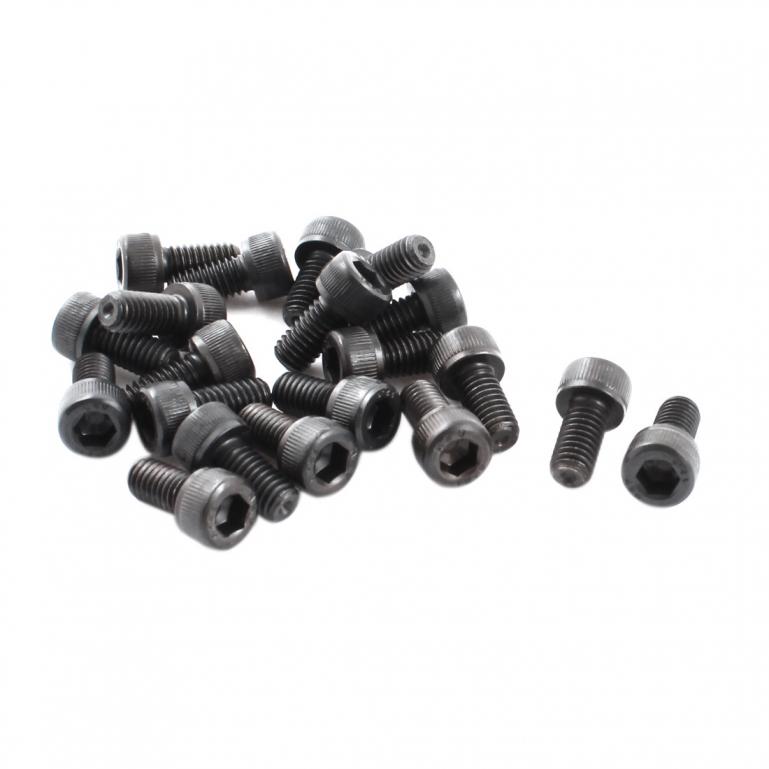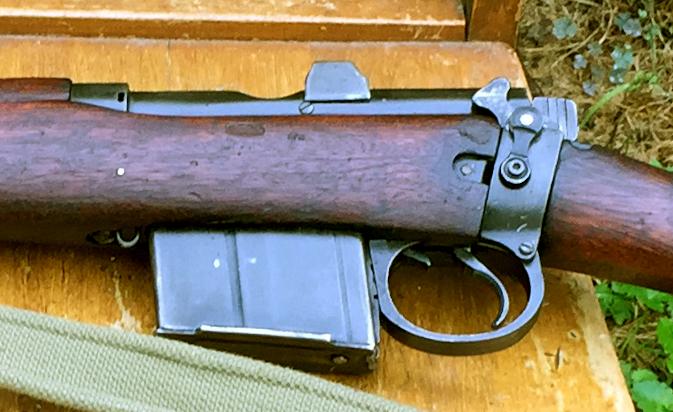-
Moderator
(M1 Garand/M14/M1A Rifles)


Getting started as a SMELLY - Ishapore 2A1
I'm just joining the SMLE family, doing so with an Ishapore 2A1. I'll admit that, coming from the Garand world, I've never owned a bolt action milsurp rifle before. I could use your advice in a couple of realms:
world, I've never owned a bolt action milsurp rifle before. I could use your advice in a couple of realms:
1. In the Garand world we use the adage, "if it rotates, oil it, if it slides grease it." Does this apply to the SMLE or, being that nothing is banged around quickly by the action, do you just oil the bolt and striker?
2. My rifle had a tight safety so I looked at the diagrams and guessed that easing the safety spring screw (#10 on the Numrich diagram) would loosen it up a bit. Yea! It worked. But... I discovered that my rifle's safety screw was different from any others I've seen on the Internet. It is a hex key screw top with a knurled circumference, that looks like this:


The finish matches the parking and wear of my rifle and the screw looks to have been there forever, but I've not seen another like it. It also appears to be metric because an SAE key is loose in it. What do you think? Field replacement? User replacement?
3. I understand the discussion of 7.62x51 vs commercial .308 ammunition, that the headspace tolerances for the 7.62 are a little more slack and the cases a little thicker so it is best to stick to 7.62 in a milsurp. Now the topic that you don't see discussed: what milsurp vs. commercial 7.62? Are you okay as long as you stick to NATO spec and lower grain values such as 146-150? There doesn't seem to be much milsurp ammo floating around during the rush but there is quite a bit of commercial 7.62.
4. I've pulled the upper handguards and compared serial numbers and they all match, all six metal locations (receiver, bolt handle, barrel, nose cap, rear sight, magazine). However, the seventh location, the lower stock fore-end, doesn't have a serial and looks like it never did. I understand the 2As and 2A1s used recycled wood and deduce that perhaps they sanded off the serial from the previous application? That would be a lot of sanding, wouldn't it?
5. Most of the 2A rifles I've seen have had an import roll mark on the receiver. This one doesn't. I checked the barrel when I pulled the handguards and there wasn't one there either. I haven't pulled the lower stock yet. Did they ever place the impot mark on the underside of the barrel?
Well, there's my opening salvo, at least. Thanks for the help!
Bob
Information
 |
Warning: This is a relatively older thread
This discussion is older than 360 days. Some information contained in it may no longer be current. |
|
"It is said, 'Go not to the elves for counsel for they will say both no and yes.' "
Frodo Baggins to Gildor Inglorion, The Fellowship of the Ring
-
-
06-04-2021 10:00 AM
# ADS
Friends and Sponsors

-
Legacy Member


Originally Posted by
Bob Womack

I understand the discussion of 7.62x51 vs commercial .308 ammunition, that the headspace tolerances for the 7.62 are a little more slack and the cases a little thicker so it is best to stick to 7.62 in a milsurp. Now the topic that you don't see discussed: what milsurp vs. commercial 7.62? Are you okay as long as you stick to NATO spec and lower grain values such as 146-150? There doesn't seem to be much milsurp ammo floating around during the rush but there is quite a bit of commercial 7.62.
It is better to stick with low bullet weight 7.62 Mil spec ammo as that is what they were designed for.
The action on the 7.62 Ishapore 2A rifle did not take kindly to being used for 7.62 and it failed the proof testing and the bodies twisted / warped and locked up solid so they reverted back to the original specified British EN steel.
EN steel.
Some internet sites suggest that the 2a is manufactured from an improved, or better steel, but in fact they are simply manufactured from the original specification steel, whilst after independence the No1 Mk3 was manufactured from an inferior steel
There was a fair bit of 'fiddling' going on after 1949 with Ishapore unilaterally changing the testing requirements & steel specifications in the No1 Mk3, then changing the specs in the 2A's.
The Ishapore proof-master (Rtd) did an interesting write up :
Extract from “Gun Digest 33rd Anniversary 1979 Deluxe Edition”
Article Author : Mr A G Harrison
Qualification : Former ‘Proof Master’ of the ‘Rifle Factory Proof House, Ishapore, India’
From 1908 to 1950 all military bolt action rifles made at Ishapore were proof tested with a dry-round, followed with by an oiled proof round. The proof cartridge was loaded to 24 tons psi breech pressure, or 15% higher than the service pressure. In 1950 (after the departure, in 1949, of India from British control) the material for the rifle bodies was altered from an EN steel to SWES 48 steel with the recoil shoulder and cam recesses being heat treated. With this change the rifle receivers distorted when oiled proof cartridges were fired. This was discovered when hard and sometimes impossible bolt retraction was experienced. Large quantities of rifles were rejected.
To avoid rejections the authorities ordered discontinuance of the oiled proof round. Therefore from 1950 to the end of SMLE production, rifles made at Ishapore were proof tested with one dry proof only, although the specification still called for both dry and oiled proof. All bolts and bolt heads issued as spares were always proofed with a dry proof round only.
A bolt action rifle similar to the SMLE MkIII*, modified to fire the 7.62mm NATO cartridge, was produced at Ishapore, first in February 1965. The receivers were made of SWES 48 steel (as per the SMLE MkIII*) and with the NATO proof cartridge the receivers were found to distort with both the dry and oiled proof round. The material was changed back to the EN steel so now the rifles stand up better to dry and oiled proof. After passing proof the barrels are impressed with the Indian national proof stamp. The bolt handles and bolt head claws are struck with the crossed flags only.
Basically it 'just' works with original 7.62 144-150gr bullets and NATO loadings, Use heavier bullets, hotter loads or 308Win hunting loads at your peril.
Just being pedantic, but the term SMELLY referred to the 303 calibre 'Short Magazine Lee Enfield' and predates 1926, after 1926 the whole rifle pool were renamed, so we now had :
Examples :
Rifle No2 MkIV* (replacing 22 Short Rifle MkIV)
Rifle No1 Mk3* (replacing ShtLe Mk3*)
Rifle No3 Mk1 (replacing the 'Pattern 14'or P14)
Last edited by Alan de Enfield; 06-04-2021 at 10:46 AM.
Mine are not the best, but they are not too bad. I can think of lots of Enfields I'd rather have but instead of constantly striving for more, sometimes it's good to be satisfied with what one has...
-
The Following 3 Members Say Thank You to Alan de Enfield For This Useful Post:
-
Legacy Member

Summary difference between 308 and 7.62
Mine are not the best, but they are not too bad. I can think of lots of Enfields I'd rather have but instead of constantly striving for more, sometimes it's good to be satisfied with what one has...
-
-
Advisory Panel


That "summary difference" card perpetuates an erroneous myth about pressures - likely the result of confusion between crusher and piezo measurements. The 62,000 psi figure cited is the current SAAMI Max Average Pressure piezo transducer figure. The 50,000 psi number is the military crusher system measurement, roughly equivalent to "CUP". MAP for .308 Win. is actually 52,000 CUP by the SAAMI crusher system. Essentially, all three pressures are the same - only the measurement systems differ. (FWIW, I suspect the headspace "difference" is also a result of different measurement systems, military and commercial.)

-
-
Moderator
(M1 Garand/M14/M1A Rifles)


Thanks, folks. But...
I've got five questions above and the .308 vs 7.62 question is not one of them. I've already decided that I won't be shooting .308 in this rifle for safety's sake. I'm trying to see if commercial 7.62x51 can be used instead of military surplus 7.62x51, which I can't find. For instance, Privi Partisan, Armcor, Federal, and others make 7.62 NATO and do so in low grain weights. Are those rounds fine for this weapon?
Oh, and does "if it rotates, oil it, if it slides grease it" still work? 
Thankee kindly!
Bob
"It is said, 'Go not to the elves for counsel for they will say both no and yes.' "
Frodo Baggins to Gildor Inglorion, The Fellowship of the Ring
-
-
Contributing Member


I'm not an expert on ammo but my 2A1 seems to work fine with the different commercial 7.62 x 51 ammo I've used. As far as oil and grease,I just use oil. The Enfield actions are so smooth that grease isn't needed IMHO. I only use grease in my M1 Garand and my M1 carbines.
Garand and my M1 carbines.
-
Thank You to Singer B For This Useful Post:
-
Legacy Member

Use oil on your LE. Never seen grease used on LE rifles.
-
Thank You to Daan Kemp For This Useful Post:
world, I've never owned a bolt action milsurp rifle before. I could use your advice in a couple of realms:


















 PM
PM










